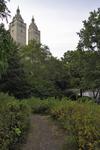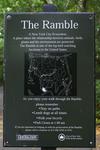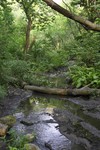














Central Park Birding:: by Location
For those of you with interest in some of the Central Park architectural features, there's both a bridges of Central Park and a secrets of Central Park site from forgotten-ny.com.
In general the most productive areas in the park are The Ramble and the areas around it. Here you'll find most of the migrant bird species, plus most of the birders. The Great Hill/North Woods is probably every bit as good bird-wise, but the birder coverage is less dense and it's just a little less safe up there - but if you prefer a somewhat more solitary birding experience this may be your preferred destination. Below, from south to north, I've listed the most interesting birding locations in the park:
 |
59th Street Pond - at the south-east corner of the park ( map), is mostly notable for an array of tame ducks througout the year (sometimes with wilder ones during the fall and winter: Wood Duck or perhaps Northern Pintail) and a good vantage point for spotting the local Peregrines that often perch on the GM building. The pond also borders the south side of Hallett Sanctuary, which is generally more productive. |
 |
Hallett Nature Sanctuary - a small four acre wooded preserve at the north edge of the 59th Street Pond ( map), fenced off and so not walkable. It attracts a variety of migrant birds but birding is restricted to the perimeter, much to the benefit of the habitat (mostly native species). In the winter of 2011/2012 an immature Red-headed Woodpecker spent some time here. |
 |
Strawberry Fields - a good place to find migrant passerines in the early morning. It is located on the western edge of the Lake, best accessed from W72nd Street and Central Park West ( map). Best known to the general public for the Strawberry Fields Memorial, for birders the mature canopy and lawns just to the north of the memorial are of greater interest. All of the common passerine migrants can be found there, together with rarer ones like Cerulean Warbler, Prothonotary Warbler and Blue Grosbeak putting in a appearance in some years. In early December 2004 Strawberry Fields hosted an adult female Rufous Hummingbird for a few days. In September 2005 a Connecticut Warbler spent nearly a week there and at the adjacent lake shore. |
 |
The Lake - (map). In early winter, when places like Turtle Pond are sometimes frozen over, the outflow of the Gill usually keeps a small thawed patch open and can concentrate overwintering ducks like Northern Shoveler, Green-winged Teal (uncommon) and Wood Duck (uncommon). More common are American Black Duck and Mallards. In spring and fall a few migrant shorebirds are found along the shores. Green Herons used to breed in the north-west corner of the Lake (the Upper Lobe) but the Conservancy's renovation of the area led to their departure, while Great Egret and Black-crowned Night Herons visit here strictly to feed. The area around Hernshead (aka the Ladies Pavilion) can be productive for warblers that feed in the nearby willows and for sparrows in the weedy edges in fall, and provides a good overlook of the lake. |
 |
Cherry Hill - rising from the southern shore of the Lake ( see map), Cherry Hill is composed mainly of tall trees with minimal understory that attract mainly tree-top species during spring and fall migrations. Warbling Vireos sometimes breed here, Long-eared Owls have sometimes roosted here in the small of groves of pines. |
 |
The Ramble - located between the east and west park drives, bordered on the south by the Lake and on the north by the 79th Street traverse, the Ramble is perhaps the pre-eminent birding location in Central Park ( see map). The trees are fairly dense here, there is some understory, and the running water along the Gill and around Azalea Pond is also a great attraction. The north shore of the lake attracts herons and passing shorebirds. The Ramble can attract a hundred or more birders at the height of spring migration and the vast majority of migrant sightings within the park are in this area. I have my own section on this site devoted to the Ramble and locations within it. Most of the birding that I do within the park is at this location. |
  |
Turtle Pond and Belvedere Castle. Turtle Pond lies on the northern edge of the Ramble, overlooked by Delacorte Theater and Belvedere Castle ( see map). The trees around the pond, especially on the south side, can be very productive for migrant passerines, while the pond itself attracts some ducks, cormorants, swallows and even one or two migrant shorebirds. The area at the east end of the point near the statue of King Jagiello (aka the "Polish Statue") can also be good for passerines. Turtle Pond was regularly visited by a small number of Black Skimmers in the summers of 2003 and 2004, and by Common Nighthawks in early summer 2005. Belvedere Castle has been for many years the location for the Central Park fall hawk watch, but is also a natural overlook into Shakespeare's Garden (to the west), Turtle Pond and the Great Lawn. The visitor's center in the castle itself can supply park checklists and has a small bird display. Shakespeare Garden, just to the west of the castle, is also a good place to check for migrants as the tree canopy is closer to eye level. Kentucky Warbler has been seen there in the past. |
| The Locust Grove and Tanner's Spring - just a little north of Belvedere Castle lies The Locust Grove (map) - a tall grove of Locust trees that attracts it's own range of migrants. It's main claim to fame in recent years has been as a prime location for one or more immature Red-headed Woodpeckers that over-winter in the park in some years (probably associated with the acorn crop in that vicinity). Over the other side of the West Drive, just north of the W81st St entrance, is Tanner's Spring (map). This is an artificial spring that forms a small pool in an area with decent understory, and can attract a whole range of small migrant birds down to bathe and drink. If you are quiet and still you can often get good looks at a whole host of warblers during good migration days, and if you a very lucky some rarity like Yellow-breasted Chat or Connecticut Warbler may drop by (my life Connecticut Warbler was at this spot). The hill above Tanner's Spring to the north is called Summit Rock and can often give you better views of the migrants that drop out of the canopy to drink and bathe in the spring. Summit Rock is similar to Strawberry Fields in terms of habitat. | |
  |
The Reservoir - (map) in early winter and early spring the Reservoir is a great attraction for ducks, gulls and the occaisional grebe and loon. Typical species are Ruddy Duck, Hooded Merganser and Northern Shoveler. Rarities seen on the Reservoir include Red-throated Loon, Glaucous and Iceland Gulls, Red-breasted Merganser and Cliff Swallow. In mid-winter it tends to freeze solid, leaving only the hardiest gulls. In summer diversity is reduced but a few Laughing Gulls can be found there, otherwise uncommon in the park. Shorebirds can be seen on the central stone dike that connects the north and south pump houses during migration (mostly Solitary and Spotted Sandpipers). The Reservoir is no longer used as a water supply for New York City. In recent years the level has been higher and the dike submerged, leading to a reduction in diversity here. |
| The North Woods and the Great Hill - much less heavily birded than the Ramble, this area is every bit as extensive in terms of habitat and attracts the same species. There's some suspicion that many birds work their way north through the park during the day and pass through this area, possibly before leaving the park and moving uptown. The Great Hill (map) is open parkland with surrounding tall trees, similar to Strawberry Fields or Summit Rock. It's to the west of the west park drive, north of the pool. The adjacent North Woods (on the east side of the same drive; map) has a more closed canopy and more extensive understory. | |
 |
The Loch - this is a small stream, reminiscent of the Gill, and so bears no resemblance to any Scottish loch. Just like the Gill (in the Ramble) the running water is a big magnet for birds, and the habitat around the Loch offers more cover. One of the more unusual sightings in the Loch was an American Bittern in May 2004. The Loch runs through a part of the north end called the Ravine whose wooded slopes are always worth checking. The Loch is formed by the outflow of the Pool, and leads out towards (but does not flow into) Harlem Meer. On the slopes to the south side of the Loch, the Wildflower Meadow can be productive for woodland edge species. |
  |
Harlem Meer - (map) is a pond a little larger than Turtle Pond at the extreme northeast corner of the park, bordering 5th Avenue and 100th Street. Most notable in the winter for regular ducks like Ruddy Duck and Bufflehead, it has been known to attract less common species like Common Merganser. There is a regular summer flyway for herons, egrets and cormorants over the north end of the park between the Hudson River and the Long Island Sound, and this is the best location to see Snowy Egret in the park (although they rarely touch down). Harlem Meer is also the location of the Dana Discovery Center which sits on the north edge of the meer. The trees on the bluffs at the southern edge of the meer are also good for migrants, although that area lacks any understory. Small fortifications to be found here are remnants from previous wars, as is the Block House in the North Woods. |
 |
Conservatory Garden - a mostly formal garden at the southeast corner of Harlem Meer is often overlooked in migration due to the abundance of habitat elsewhere, and the fact that regular replanting disturbs the habitat. Nevertheless this place can be particularly rewarding during winter when the fruiting trees attract finches and sparrows (which also get fed by people) - sometimes unexpected birds like Ring-necked Pheasant have been encountered here and a probable Allen's Hummingbird (an immature female of genus Selasphorus) was found here in November 2002, leaving shortly before Thanksgiving. |
Another area worth of mention is the Pinetum . Stands of evergreen trees are fairly uncommon in the park and the Arthur Ross Pinetum has the largest of all. This often proves to be a big attractor for birds with a preference for evergreens, and the deciduous trees along it's perimeter are good for other migrants, particular the trees along the north edge. An unusual number of late Cape May Warblers were found in the Pinetum in October 2004.
Finally, two more ponds are worth noting: the Pool is at the south-west end of the Loch and borders the south side of the Great Hill. A few waterfowl spend their time there and from time to time something slightly more exotic like Wood Duck might turn up. The surrounding trees are predictably good for warblers. The Conservatory Water (aka the Model Boat Pond) is really just a shallow concrete basin and so birds hanging out there are usually restricted to Mallards and sometimes a Double-crested Cormorant. The east shore of this pond is the usual gathering point for birders that watch the Red-tailed Hawk nest (Pale Male and Lola) on 5th Avenue. However in 2003 Black Skimmers sometimes visited the Conservatory Water after dark (they were also found more reliably at Turtle Pond, which is a short distance away).
Pretty much anywhere in the park has the potential of turning up migrant birds - on good migration days they can be found all over the park.
The Ramble usually has a fair number of people around, and there's also a police presence, so that's relatively safe although there is a small amount of annual crime there. The Ramble is, however, nearly as well known amongst a small minority of the gay community as a cruising location as it is for birding. On warm summer afternoons there can be quite a few men looking for others of the same gender. I've personally been approached only the once in several years of birding the park (apparently the large camera was not sufficiently informative to the gentleman in question) but then again I'm really not that cute. Everyone's reaction to this varies, but sometimes the activity is a little too prominent for some people's tastes. Warm afternoons and evenings have the most activity, and the Point is perhaps the location in which things are the most obvious. I make a specific point of never letting this get in the way of birding. If you feel something grossly inappropriate is going on, I suggest calling the police. After dark, however, the Ramble is mostly unlit and this sort of activity increases markedly on warm days. I've had no negative crime-related incidents in the park, but then I am 6'2" tall and male, so I'm not an easy target despite carrying around a lot of expensive camera hardware. I consider the park rather safe, but it's not like I leave my belongings lying around unattended either.
The North Woods certainly has an edgier vibe to it than the Ramble, in part because the understory there is more extensive and there are less people (and police) than in the Ramble. I don't bird the North Woods as much (although more so lately) but it may pay to bird there together with someone else unless you feel comfortable in such situations. I'm not sure it would be a smart move to bird there after dark on your own. In fact you shouldn't be wandering around the park after dark unless you've got enough street smarts to handle yourself in dimly lit environments or you are with someone else. Again, common sense should prevail here. The infamous and brutal Central Park Jogger attack in 1989 was along the 102nd Street Cutoff between the east and west park drives just south of the Ravine (near the Wildflower Meadow) in the north end of the park. There's a small police booth close to that location, often manned. The Central Park Precinct is on the 86th Street park traverse. Their phone number is (212) 570-4820. Use the good old 911 if you are unlucky enough to have an emergency situation.
The Gotham Gazette carried a small but informative article on Central Park crime back in 2003. Recently (December 2011) the NY Times published an article about how the park is generally considered quite safe even at night now, not that it offers as many birding opportunities.
Comments etc to my email address.